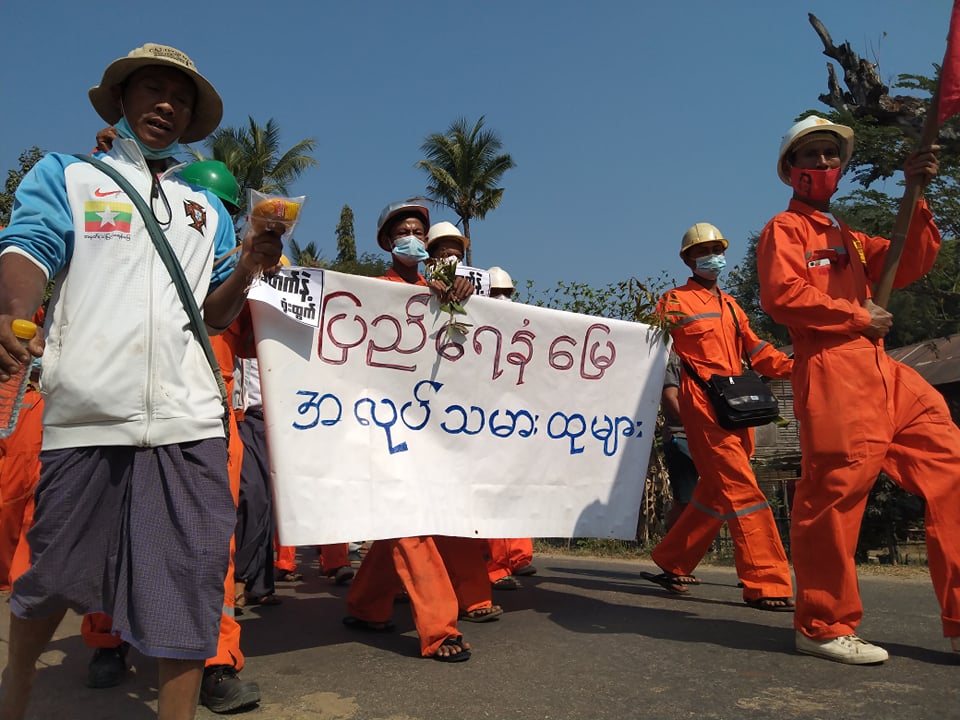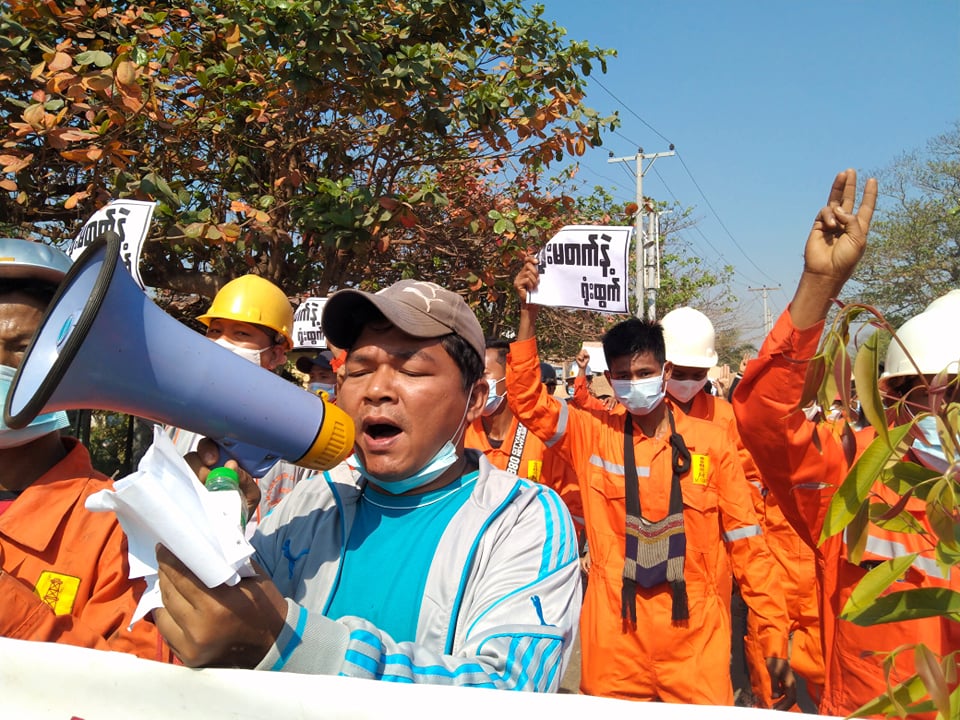Article 33 Action Against Myanmar: Workers Fear the Cure Hurts More Than the Disease
Text by Josephine Kyi / Edit by Shwe Nakamwe / Pictures by Shwe Zin Soe
YANGON // Local garment workers and labour leaders in Myanmar say the International Labour Organization’s (ILO) decision to invoke Article 33 – a rare punitive measure against member states that persistently violate core labour conventions – may end up harming workers more than the junta it targets.
In June 2025, the ILO triggered Article 33 sanctions against Myanmar for breaching Convention No. 87 (Freedom of Association and Protection of the Right to Organize) and Convention No. 29 (Forced Labour). It was the second time the measure had been used against Myanmar – the first being in 2000 under the Than Shwe military regime. In 2000, the ILO adopted a resolution under Article 33 of its constitution to address Myanmar’s widespread use of forced labor, marking the first time this article was invoked against a member state. Khin Nyunt, then chief of intelligence and a key figure in Myanmar’s military regime, was a major representative for the country in discussions with the ILO.
Article 33 empowers ILO member states to review their engagement with offending governments and consider actions such as suspending cooperation, investment, or trade. While Article 33 does not automatically impose trade bans, local worker leaders described it as an extremely severe measure within the ILO system, one they fear will harm workers more than the authorities.
Workers say they understand why Myanmar was penalized but argue that the measure risks worsening their economic hardship rather than pressuring the junta.

Post-Coup Labour Conditions
Research and testimony from CMP (cut–make–pack) factory workers show a steep decline in labour rights and workplace safety since the 2021 coup. Workers describe low wages, forced overtime, and excessive hours – sometimes up to 21 hours a day. Many cite unsafe, unventilated, and unsanitary conditions, restrictions on union formation, and verbal or physical abuse from supervisors. Some report being forced to sign blank documents, denied leave, or transferred as punishment for speaking out.
The report Stitches of Struggle and Hope found that 55 percent of surveyed workers reported average 12-hour shifts (rising to 21 hours in extreme cases), 62 percent had sustained physical injuries, and 60 percent reported work-related psychological distress.
These findings align with what local organizers describe as the most repressive period for Myanmar’s labour force in decades.
Why Article 33 Was Invoked
The ILO justified its decision by citing Myanmar’s ongoing violations of Conventions 29 and 87. The National Unity Government (NUG) had urged this escalation, coordinating with exiled trade unions and employer representatives. The NUG hailed the move as “a victory of the people,” calling on ILO member states to review cooperation with the junta, suspend transfers of aviation fuel, weapons, and financing that support military operations, and hold both state and private actors accountable for forced labour.
Yet, ground-level workers say they were not consulted. They argue that the decision was made far from the realities they face, with little understanding of how sanctions could compound their vulnerability.

Economic Scale and State Claims
State media such as the Global New Light of Myanmar reports roughly 700 garment factories across the country and 700 000 workers in Yangon alone. The junta also claims that garment exports generated about five billion USD annually between 2021 and 2024.
Union representatives point out that these figures, though possibly inflated, illustrate how dependent the junta has become on garment exports – and why the brunt of sanctions falls on workers rather than generals.
Workers and Unions Respond
Ma Zin Mar, a union leader in Hlaing Thar Yar, voiced frustration with the policy:
“If we support Article 33, tell us clearly how long it will take to remove the junta. Who can promise that? You can’t ask 700 000 workers who depend on this sector to absorb that shock.”
Her tone was skeptical, not supportive.
Veteran labour activist, U Tun Wai Nyunt, who has campaigned for more than twenty years, said:
“Stopping factories doesn’t hurt the generals at all – it destroys workers’ livelihoods. Target their income, not ours.”
He added that sweeping punitive actions “do not help democracy, peace, or federalism” and warned that measures harming the working class risk undermining the broader revolution.
CCTU (Cooperating Committee of Trade Unions) survey reportedly found that 98 percent of respondents opposed factory shutdowns, citing survival needs. Our previous article on urban poverty touches on the risks of social breakdown.
Representation and Consultation
The ILO operates through a tripartite system that includes representatives of workers, employers, and governments. Both the NUG and the junta claim to maintain such structures.
At the 113th International Labour Conference (2025), the ILO recognized the NUG delegation rather than the junta’s, though both listed the Confederation of Trade Unions Myanmar (CTUM) as worker representative.
U Tun Wai Nyunt criticized this process:
“Representatives should be chosen democratically by workers themselves. How can decisions about labour rights in Myanmar be made in Geneva without asking workers here?”
Ko Kane, a 25-year-old factory union leader, echoed the concern:
“ILO feels far away from us. Even we union leaders aren’t sure whether it still has an office here. Many workers have never heard the name ‘ILO’.”
He added that workers had no chance to express their opinions before the Article 33 decision was made.
Employer Complicity and Union Suppression
Ko Kane described how efforts to form a legal union at his factory were sabotaged. The list of workers supporting the initiative was leaked to management, leading to intimidation, forced overtime, and dismissals. He himself was transferred to unrelated construction work and later pressured to either cooperate with management or leave.
“Directly jumping to Article 33,” he said, “is like burning the house for a mouse.”
U Tun Wai Nyunt noted that employers share responsibility for abuses:
“It’s not only the government blocking unions – many employers themselves participate. The ILO should engage not just authorities but also factory owners and brand representatives, holding them to account.”
Their testimonies point to a pattern of joint repression by both state and private actors.




[ Pictures above: Oil field workers protest in Pyay as part of the Civil Disobedience Movement in February 2021. ]
Lessons from the 2000 Precedent
Myanmar’s first experience with Article 33 in 2000 offers a cautionary parallel. Despite the measure, the State Peace and Development Council (SPDC) regime under Than Shwe and Khin Nyunt remained in power. Factories closed, workers lost jobs, and the junta later consolidated control through the 2008 Constitution and the 2010 elections, which reserved 25 percent of parliamentary seats for the military.
“We never said don’t act against the junta,” U Tun Wai Nyunt said. “We only said: don’t take actions that hurt the people. Go after the junta’s real revenue streams.”
He cited extractive industries as examples:
“No one objected when Total or other oil giants left. But those companies never employed our people. They just took our resources.”
For him and many others, effective sanctions would target the junta’s actual income sources, not the industries sustaining ordinary families.
International Reactions and Trade Context
In July 2025, the Donald Trump administration announced a 40 percent tariff rate on imports from Myanmar – a move the junta welcomed as a sign of semi-normalization after years of near-total sanctions. The rate did not restore Generalized System of Preferences (GSP) benefits but allowed Myanmar exporters, particularly in the garment sector, to operate under a legally defined tariff rather than facing full embargo restrictions.This shift gave the regime both a public-relations victory and a new pathway for export revenue, even as sanctions on military-linked conglomerates remained. It also offered Western importers a legal route to continue sourcing from Myanmar without breaching sanctions, loosening the economic chokehold that had previously limited trade.
Regional analysts note that the U.S. remains Myanmar’s fourth-largest garment export destination. The junta used the tariff adjustment to project economic recovery and legitimacy, though workers say it has not restored job security or improved wages.
Labour leaders also referred to ongoing discussions with the European Union, Myanmar’s largest garment-export market.
They believe the EU will avoid a full disengagement like that of 2000, instead opting for targeted due-diligence measures requiring brands to account for labour conditions in their supply chains.
Myanmar’s garment industry continues to rely on investors from Taiwan, China, South Korea, and Macau, whose reactions to the Article 33 decision remain uncertain.
The ILO’s invocation of Article 33 was designed to hold Myanmar’s junta accountable for systematic labour-rights violations. Yet among the country’s workers, it is viewed with ambivalence – a blend of hope for justice and fear of economic collapse.
Workers repeatedly stress one demand: direct engagement. As Ma Zin Mar said, “You can’t see from above. Come down, and you’ll understand what’s happening between workers and employers.”
The dilemma remains unresolved – how to punish a regime without punishing its people.
References
Business & Human Rights Resource Centre (2025) Myanmar: Garment, bag & shoe manufacturing expected to suffer following 40 % US tariff announcement.
CCTU – Cooperating Committee of Trade Unions (2024) Survey on Working Conditions and Worker Attitudes toward Sanctions.
Yangon: CCTU Publications.
Global New Light of Myanmar (2024) Garment sector export performance and industrial workforce statistics.
Naypyidaw: Ministry of Information.
ILO (2001) Implementation of Article 33 Measures concerning Myanmar (First Invocation Report).
Geneva: International Labour Organization.
ILO (2025) Decision on the Application of Article 33 Measures against Myanmar for Violations of Conventions 29 and 87.
Geneva: International Labour Organization.
ILO (2025) 113th International Labour Conference Record of Proceedings.
Geneva: International Labour Organization.
NUG – National Unity Government (2025) Statement on the ILO Article 33 Decision and Call for International Action against the Myanmar Military. Naypyidaw (exile office).
Stitches of Struggle and Hope (2024) Labour Rights in Myanmar’s Garment Industry after the Coup.
Yangon: Local Labor Research Network.